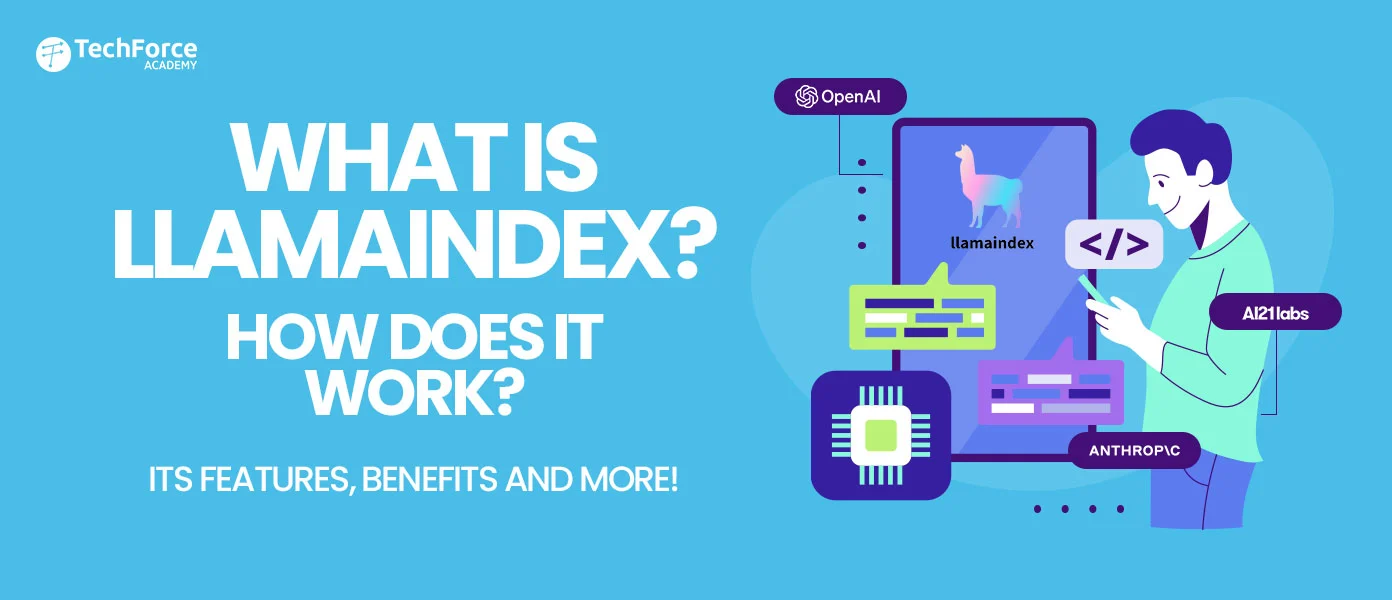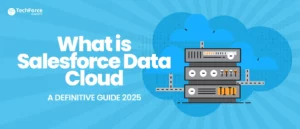Large Language Models (LLMs) are powerful tools that can access and process information from many different sources. However, because they are trained on general data, they might not perform as well on specialised tasks. This is where the role of LlamaIndex comes in.
Users can connect the LLM’s extensive knowledge base with specific data through the LlamaIndex architecture. Because of this, LLMs can perform creative and analytical activities more effectively when they are applied to the user’s area of interest.
What is LlamaIndex?
LlamaIndex is a powerful AI tool which was introduced after the GPT launch in 2022. It makes the process of developing large language model (LLM) applications easier. Regardless of your degree of AI experience, LlamaIndex provides customizable APIs to fit your needs.
Formerly known as the GPT Index, LlamaIndex helps developers connect different types of data to LLMs. You can use it with files like PDFs and PowerPoints, apps like Notion and Slack, and databases like Postgres and MongoDB. It has many connectors to bring in data easily and work smoothly with LLMs. LlamaIndex also has a smart system to retrieve and query data, giving detailed and context-rich answers to any prompt you provide.
Simply put, LlamaIndex acts as a bridge between your data and an LLM. It creates an index from your data, which is used to answer any related questions. Depending on what you need, LlamaIndex can create various types of indexes, such as vector, tree, list, or keyword indexes.
How Does LlamaIndex Work?

Ingestion
LlamaIndex has hundreds of data loaders that let you connect different data sources to LLMs. It can connect to services like Airtable, Jira, and Salesforce, as well as load data from files, JSON documents, CSV files, and unstructured sources.
You can find a full list of data loaders on the Llama Hub.
Indexing
After bringing in the data, it needs to be organised so it can be easily searched by an LLM. LlamaIndex represents data in many dimensions, making it more useful. This is called a vector index. Once data is organised this way, it can be used for semantic search, meaning it can find related items easily.
Querying
The true power of LlamaIndex and LLMs is in querying. The prompt engineering of LlamaIndex makes data querying easy and natural language-based. You can simply ask queries and receive replies after your data is structured.
By streamlining data ingestion, indexing, and querying, LlamaIndex facilitates the development of robust AI applications.
Importance of Indexing in Data Management
Accurate and fast data retrieval is made possible by effective indexing, which is essential for large-scale data management. In a time when data is expanding exponentially, tools like LamaIndex help maintain accessibility and order, enabling valuable data to be located and used efficiently.
It’s a specialised framework that takes indexing a step further. Instead of focusing on general data retrieval, LlamaIndex tailors indexing specifically for LLMs. LlamaIndex gives LLMs the ability to gain and understand knowledge much more quickly by building a special library tailored for AI researchers. Because of this, it is perfect for creating reliable natural language processing (NLP) applications, such as question-answering chatbots and systems.
Key components of LlamaIndex

LlamaHub
- Freely accessible repository of data loaders.
- Provides access to over 100 different data sources and formats.
- Can handle multimodal documents (e.g., converting image text into analysable format).
Core query functions
Index
- Data structure for fetching information from documents based on a user’s query.
- Divides documents into “Node” objects and builds an index from them.
- Foundational for Retrieval Augmented Generation (RAG) of information.
Retriever
- A tool that uses a user’s query to extract relevant data.
- Can be developed on top of Indices or independently.
- Crucial for building Query Engines and Chat Engines.
Query Engine
- Universal interface for querying data.
- Various forms to accommodate different needs.
Chat Engine
- Advanced interface for conversation with your data.
- Similar to a Query Engine with statefulness (remembers conversation history).
- Responds considering the context of past interactions.
Key Features of LlamaIndex
LlamaIndex has many useful features that make working with AI and large language models (LLMs) easier. Here are the main ones:
- Data Connectors: Bring in data from different sources and formats easily.
- Document Operations: You can add, delete, update, and refresh documents in the index.
- Data Synthesis: Combine information from multiple documents or different sources.
- Router Feature: Choose between different query engines to get the best results.
- Hypothetical Document Embeddings: Improve the quality of the answers you get.
- Integrations: Compatible with a wide range of tools, including LangChain, ChatGPT plugins, vector storage, and tracing tools.
- OpenAI Function Calling API: Supports the latest API for advanced functions.
LlamaIndex is flexible and lets you change several parts to fit your needs:
- Large Language Model (LLM)
- Prompt Templates
- Embedding Models
- Documents
Benefits of LlamaIndex
- Easy Data Connection: Connect data sources like APIs, PDFs, SQL, NoSQL, and documents for use with AI applications.
- Store and Index Data: Easily integrate private data into vector databases for use in a variety of applications.
- Smart Query Interface: A built-in tool that gives detailed answers from your data.
Use Cases for LlamaIndex

- Chatbots: Create chatbots that use your product info to interact with customers naturally and in real-time.
- Smart Agents: Create intelligent agents that can adjust to shifting data and options for decision-making.
- Data Interaction: Use natural language to work with large amounts of structured data easily.
- Enhanced Data: Combine public data with your private data for specific application needs.
To learn more about LlamaIndex, enrol in our course Generative AI with OpenAI, LangChain, and LlamaIndex
Potential Challenges and Limitations of LlamaIndex
LlamaIndex is a strong tool for organising and searching data, but it has some challenges. Here are some potential issues you might face:
Data Volume and Indexing Speed
Handling a lot of data can be hard. LlamaIndex might have trouble quickly organising big datasets, which can slow down the finding of information.
Integration Complexity
Connecting LlamaIndex with your current systems or different data sources can be tricky and so this often needs technical skills and can take a lot of time.
Accuracy and Relevance of Results
Making sure search results are accurate and relevant can be a challenge. Setting up LlamaIndex to give the best results for specific searches needs careful setup and ongoing adjustments.
Scalability
As your data grows, keeping LlamaIndex working well without using too many resources can be tough. Scaling up to handle more data efficiently is a challenge.
Maintenance and Updates
Regular maintenance and updates are important for LlamaIndex to work properly. Keeping up with the latest updates and making sure everything works well with your other systems can be demanding.
Different Index Types in LlamaIndex

LlamaIndex offers many ways to organize your data and each way is tailored to meet specific requirements. Here, in this section, we will discuss the various index types that may be created using LlamaIndex, their functions, and the ideal applications for each.
1. List Index
A list index arranges data in a simple list. First, the data is broken down into smaller parts called nodes. These nodes are then put in order. When you search this index, it goes through the nodes one by one, unless you set it to do something else. You can also search using keywords or embeddings.
The list index is useful for going through data in order, even if the data is large. Even if you have more data than the language model can typically process at once, LlamaIndex can manage it all.
2. Vector Store Index
A vector store index stores data as vector embeddings, which are mathematical representations. These can be kept in a special database like Milvus. When you search this index, LlamaIndex finds the most similar nodes and returns them. This type is great for comparing texts based on their meaning, making it ideal for understanding semantic similarity.
3. Tree Index
Data is arranged into a tree structure using the tree index. Starting at the bottom with the initial data, it grows up and summarizes as it goes. The tree index can be used to swiftly locate information when searching by moving from the top down. This makes it efficient for searching large texts and finding information from different parts of the text without going through it in order.
4. Keyword Index
A keyword index maps keywords to the nodes that contain them. Each keyword can link to many nodes, and each node can have many keywords. When you search, it looks for the keywords and only searches the linked nodes.
This type is very efficient for searching large amounts of data for specific keywords, especially when you know what the search will focus on, like finding COVID-19 information in healthcare documents.
5. Knowledge Graph Index
A knowledge graph index creates an index from knowledge triples (subject, predicate, object) found in documents. You have two options for providing context for your search: you can use the knowledge graph or incorporate text from each entity. This allows for more complex searches about the document content.
Future Developments and Roadmap
Upcoming Features
New features and improvements are frequently introduced to LlamaIndex. The goal of the development team is to make LlamaIndex even more powerful while maintaining its status as a modern data indexing and retrieval tool.
Long-Term Vision and Goals
The long-term vision for LlamaIndex is to become the go-to solution for data management and retrieval. The development team aims to do this through continuous platform enhancements, new feature introductions, and improved integration potential.
Conclusion
LlamaIndex is a valuable resource for developers and companies alike since it is an effective tool that streamlines data administration and retrieval. Because of its flexibility, scalability, and advanced indexing and query capabilities, users may effectively handle and retrieve massive volumes of data.
As LlamaIndex continues to evolve, it promises to remain at the forefront of data indexing and retrieval solutions, providing users with the tools they need to harness the full potential of their data.











